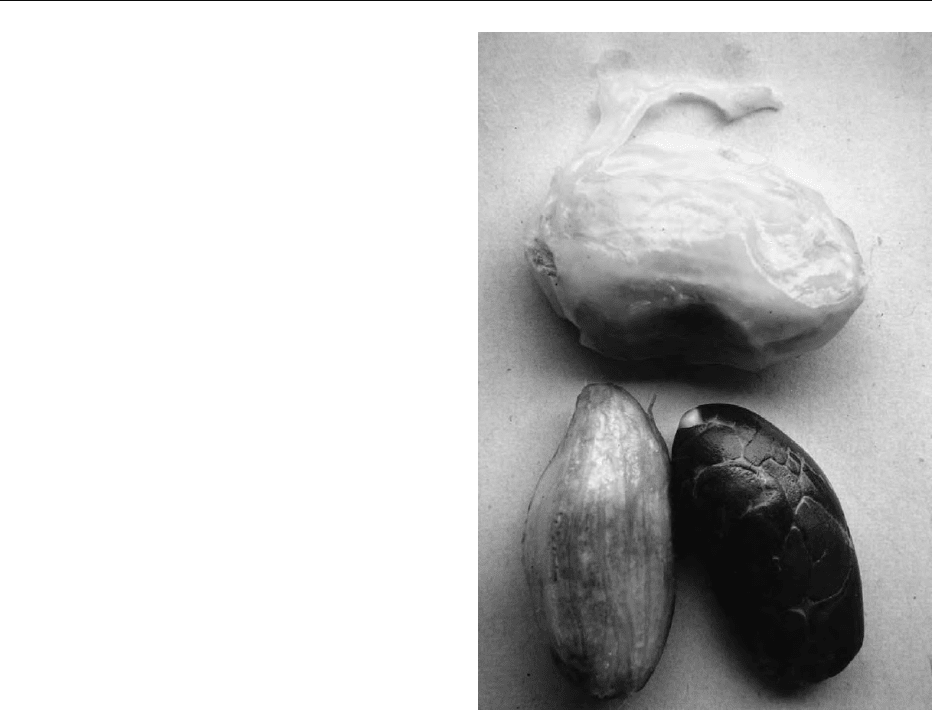Caballero B. (ed.) Encyclopaedia of Food Science, Food Technology and Nutrition. Ten-Volume Set
Подождите немного. Документ загружается.


for cobalt speciation analysis. The cyanocobalamin
form of cobalt has been measured in blood serum,
seminal fluid, and milk serum. Vitamin B
12
analogs
have also been determined in animal carcass tissue.
These speciation techniques should see intense devel-
opment in future.
0028 Neutron activation analysis can be used to
determine the amount of cobalt in biological and
environmental samples; typical detection levels are
0.03 mgg
1
. This technique usually requires a post-
irradiation period of around 3 weeks before g-ray
emission from the
60
Co isotope can be measured.
Radiation flux levels are usually around 10
12
–10
13
neutrons cm
2
s
1
. Concentration techniques using
dithiocarbamate complexation are usually applied
to improve detection levels.
See also: Chromatography: High-performance Liquid
Chromatography; Cobalamins: Properties and
Determination; Physiology; Mass Spectrometry:
Principles and Instrumentation; Applications
Further Reading
Barceloux DG (1999) Cobalt. Journal of Toxicology –
Clinical Toxicology 37: 201–216.
Brown S and Savory J (1984) Chemical Toxicology and
Clinical Chemistry of Metals. New York: Academic
Press.
Schneider Z and Stroinski A (1987) Comprehensive B
12
.
Berlin: Walter de Gruyter.
Smith IC and Carson BL (1981) Trace Metals in the
Environment. Cobalt, vol. 6, pp. 1202. Ann Arbor, MI:
Ann Arbor Science.
Smith KA (1990) Soil Analysis, Modern Instrumental
Techniques, 2nd edn. New York: Marcel Decker.
Smith RM (1987) Cobalt. In: Mertz W (ed.) Trace Elements
in Human and Animal Nutrition, 5th edn. London:
Academic Press.
Underwood EJ and Suttle NF (1999) The Mineral Nutrition
of Livestock, 3rd edn. Wallingford, UK: CAB Inter-
national.
Ysart G, Miller P, Crews H et al. (1999) Dietary Exposure
estimates of 30 elements from the UK Total Diet Study.
Food Additives and Contaminants 16: 391–403.
Cockles See Shellfish: Characteristics of Crustacea; Commercially Important Crustacea; Characteristics of
Molluscs; Commercially Important Molluscs; Contamination and Spoilage of Molluscs and Crustaceans;
Aquaculture of Commercially Important Molluscs and Crustaceans
COCOA
Contents
Chemistry of Processing
Production, Products, and Use
Chemistry of Processing
B Biehl, Technische Universita
¨
t Braunschweig,
Germany
G Ziegleder, Fraunhofer-Institut fu
¨
r Verfahrenstechnik
und Verpackung, Freising, Germany
Copyright 2003, Elsevier Science Ltd. All Rights Reserved.
Introduction
0001 The most valuable constituents in cocoa are cocoa
butter and flavors. Both are specific for seeds of
Theobroma cacao L. Whilst the quality of cocoa
butter is not changed during processing, the particu-
lar flavor of cocoa depends on profound chemical
reactions which take place during processing and
manufacturing. The unprocessed cocoa seed would
not give the characteristic flavor when roasted unless
it was first fermented and dried. The sequence of raw
cocoa processing in the tropics and then manufactur-
ing is essential since reactions during fermentation
depend on water and enzymes of the living seed,
whilst manufacturing comprises nonenzymatic reac-
tions in a dry lipid phase. Raw cocoa beans are the
link between processing (normally in the tropics)
and manufacturing (normally in the consuming
1436 COCOA/Chemistry of Processing

countries). A large number of essential constituents of
cocoa flavor are produced during roasting of raw
cocoa from flavor precursors formed during tropical
processing. Reactions during fermentation and drying
resulting in raw cocoa beans and subsequent reac-
tions taking place during manufacturing are de-
scribed in this first article.
Chemistry of Raw Cocoa Processing
0002 Both the seeds and the pulp are essential components
in raw cocoa processing. However, the reactions
which are essential for raw cocoa quality take place
within the seeds alone and not in the pulp. Enzymes
of the seeds are directly involved but microorganisms
only indirectly, in that bacteria and fungi are respon-
sible for the degradation of the pulp, and their
metabolites, especially acetic acid, which are instru-
mental in the subsequent changes in the seeds. Organ-
isms participating in the direct attack on the nibs
during the late stage of fermentation and overfermen-
tation are also important.
0003 Processing depends on the chemical composition
and physiological state of the beans, their enzymes,
and their pre- and postmortem subcellular structures.
They greatly affect the final product quality.
Biology of the Seed
0004 Two commercially exploited types of the species T.
cacao, Criollo and Forastero, are distinguished on the
basis of fruit morphology and geographic origin. Cri-
ollo gives fine-flavor cocoas, although in low yields,
while the more vigorous, high-yielding Forastero
subtypes and hybrids predominate in plantations
worldwide. Cocoa pods contain about 35–45 seeds
consisting of the embryo and the shell, which is
covered when ripe by a mucilaginous pulp, the endo-
carp (Figure 1). The main parts of the embryo are two
folded cotyledons connected by a small embryonic
axis. A rudimentary, skin-like endosperm covers the
surface of the embryo. After fermentation the shell,
covered with residues of pulp, comprises about 12–
16% of the seed dry weight, depending on bean size
and pulp degradation during fermentation. The dry
weight of a seed varies considerably, but is ap-
proximately 1.0–1.2 g. Only the cotyledons are
used for cocoa and chocolate manufacturing and in
these the leaf mesophyll is the dominating tissue,
consisting of two types of cells which differ in com-
position.
0005 About 80% of the cells store lipid and protein, the
major volume of which is occupied by a large number
of individual lipid bodies of constant size (about
2 mm) surrounding one or more branched protein
storage vacuoles and amyloplasts. The remaining
20% of the cells are polyphenol storage cells. Their
lumen is almost entirely occupied by one central
vacuole containing all the stored polyphenols and
purines.
0006Subcellular structures in the lipid and protein stor-
age cells control pre- and postmortem reactions
during fermentation, which are not the same as in
cell free systems. On the subcellular level in vivo,
the situation can roughly be described as a dispersed
lipid phase (lipid bodies) in a continuous water phase
(cytoplasm; Figure 2). During fermentation, the cells
are killed by heat and acetic acid, but postmortem
structures are maintained. In the cell lumen, with low
concentrations of acetic acid, the lipid bodies fuse in
situ, and they form, more or less, a continuous lipid
phase which separates cytoplasmic inclusions as a
hydrophilic dispersed phase. In contrast, in the pres-
ence of a high concentration of acetic acid, fusion of
the lipid bodies is more extensive, causing complete
fig0001Figure 1 Unfermented cocoa seeds showing the pulp, the testa
and the cotyledons. Reproduced from Cocoa: Chemistry of Pro-
cessing. Encyclopaedia of Food Science, Food Technology and Nutri-
tion, Macrae R, Robinson RK and Sadler MJ (eds), 1993,
Academic Press.
COCOA/Chemistry of Processing 1437

segregation of the lipid in the cell center (Figure 2). In
the first case, intracellular diffusion of water-soluble
compounds is reduced by lipid barriers. In the latter
case, diffusion is not restricted. Proteolysis, browning
reactions, acid diffusion, and flavor precursor forma-
tion mutually depend on these structures.
Composition of Unfermented Cocoa
Seeds
0007 The prominent secondary compounds are flavonoids
and purines (theobromine and caffeine). The storage
reserves include predominantly cocoa butter but also
protein and starch. All these compounds are stored in
the cotyledons. The composition of ripe seeds is
shown in Table 1. Differences of cocoa butter, pro-
teins, and pigments are found between Forastero and
Criollo types.
Cocoa Butter
0008 Fat, the main storage component, on average com-
prises 53–58% of the cotyledon dry weight. It con-
tains about 95% triacylglycerols, 2% diacylglycerols,
<1% monoacylglycerols, 1% polar lipids, and 1%
free fatty acids (as percentages of lipids). Triacylgly-
cerols consist of about 37% oleic (O), 32% stearic
(S), 27% palmitic (P) and 2–5% linoleic (L) acids (as
percentages of total fatty acids). Other saturated and
monounsaturated fatty acids do not contribute more
than about 2% of the fatty acids. These values are
typical of fermented beans but do vary between
samples, and between genetic and geographic origins.
This is also true of the complex fatty acid composition
in triacylglycerols. In cocoa butter, the disaturated
triacylglycerols, mainly POS, SOS, and POP predom-
inate by far over monosaturated triacylglycerols,
tbl0001Table 1 Analyses of unfermented West African cocoa
Constituent Dried beans (%)
Cotyledons 89.60
Shell 9.63
Embryonic axis 0.77
Fat 53.05
Water 3.65
Ash (total) 2.63
Nitrogen
Total nitrogen 2.28
Protein nitrogen 1.50
Ammonia nitrogen 0.028
Amide nitrogen 0.188
Theobromine 1.71
Caffeine 0.085
Carbohydrates
Fructose (0.09)
Glucose 0.30 (0.07)
Sucrose 0 (2.48)
Starch 6.10
Pectins 2.25
Fiber 2.09
Cellulose 1.92
Pentosans 1.27
Mucilage and gums 0.38
Tannins (total phenolics) 7.54 (13.5)
Acids
Acetic (free) 0.014
Oxalic 0.29
After Rohan (1963) with permission of the Food and Agriculture
Organization of the United Nations, except data in parentheses for sugars
in Bahia from Berbert (1979). Total phenolics from Swain (1954) as cited by
Rohan (1963) assuming 55% fat; see Further Reading.
Acetic acid
0.035mol l
−1
Acetic acid
0.200mol l
−1
Premortem
Postmortem Postmortem
fig0002 Figure 2 Schematic representation of electron microscopic aspects of postmortem changes in mesophyll cells caused by different
concentrations of acetic acid during fermentation-like seed incubation. Spherical lipid globules in the living cell fuse in situ (left) or
form a central bulk of lipid (right). Hydrophilic compartments are indicated by dots or dashes. Reproduced from Cocoa: Chemistry of
Processing. Encyclopaedia of Food Science, Food Technology and Nutrition, Macrae R, Robinson RK and Sadler MJ (eds), 1993, Academic
Press.
1438 COCOA/Chemistry of Processing

mainly POO and SOO. The melting temperature of
cocoa butter at 31–34
C is an essential characteristic.
Differences of fat hardness are reflected in the iodine
value of cocoa butter and the ratio of disaturated to
monosaturated triacylglycerols (Table 2B, C).South
American cocoas are the softest compared with cocoa
from Asia and Africa. Storage fat accumulation
during seed development undergoes characteristic
changesinfattyacidcomposition(Table 2A).Cli-
mate, demonstrably the ambient temperature and
stress due to heat or drought, affects biosynthesis
and thus the final composition of triacylglycerols,
and the melting and crystallization characteristics of
cocoa butter. Whilst the amount of fat per seed
depends on both, genetics and physiology of pod
development, effects due to genetic differences or the
process of fermentation on cocoa butter quality are
not unequivocal. (See Fatty Acids: Properties; Trigly-
cerides: Structures and Properties.)
Polyphenols
0009 Flavonols are the major components. The order
of quantities in Forastero types is (approximate
weight percentages of total polyphenols): proantho-
cyanidins (58–65%), catechins (29–38%), then
anthocyanins (1.7–4.0%). Specific compounds
detected include: anthocyanins (3-a-l-arabinosidyl
cyanidin and 3- b-d-galactosidyl cyanidin); catechins
(()-epicatechin, (þ)-catechin, (þ)-gallocatechin,
()-epigallocatechin). Additionally, several (up to
eight) proanthocyanidins (di- and oligomeric) and
proanthocyanidinglycosides (predominantly based
on ()epicatechin) have been isolated and identified.
Three flavonols have been found as minor constitu-
ents: quercitin, quercitin-3-glucoside, and quercitin-
3-galactoside. Up to 17 phenolic acids and esters have
also been reported. The total amount of seven of
them comprise not more than 23 p.p.m. of the seed
dry weight (phloroglucinol, protocatechuic acid,
vanillic acid, o-hydroxyphenylacetic acid, p-couma-
ric acid, caffeic acid, ferulic acid). (See Tannins and
Polyphenols.)
0010Anthocyanins and their aglyca are lacking in Cri-
ollo-type seeds but provide the characteristic color of
Forastero seeds. They are also taken as an indicator of
the ‘degree of fermentation.’ Colorless proanthocya-
nidins and catechins are strongly astringent and are
effective tannins. Their enzymatic oxidation and
polymerization cause browning reactions after cell
wounding and reduction of astringent taste. Cocoa
polyphenols are strong antioxidants which are
increasingly considered as antioxidative protectors
in food. (See Colorants (Colourants): Properties and
Determination of Natural Pigments.)
Alkaloids
0011The composition of methylxanthines in cocoa seeds is
genetically variable but characteristic of cocoa. Theo-
bromine (1–2%, dry weight) and caffeine (0–2%, dry
weight), together with traces of theophylline and 7-
methylxanthine, are found. They are not metabolized
during fermentation. Theobromine plays a role in the
bitter taste of cocoa. Several phenolic amines and
alkaloids derived from tyrosine and tryptophan
have been detected at very low levels (3–40 mgg
1
)
in both unroasted and roasted cocoas. (See Alkaloids:
Toxicology.)
Sugars and Acids
0012Besides a total of around 12% (dry weight) of poly-
saccharides (Table 1), the free sugar content in cocoa
seeds is not more than 2–4% (dry weight). Sucrose is
the major component (about 90% of total sugars),
followed by fructose plus glucose (about 6%). In
addition, galactose, raffinose, melobiose, sorbose,
mannotriose, xylose, arabinose, mannitol, and inosi-
tol have been detected by several investigators in
tbl0002 Table 2 Data reflecting differences of cocoa butter hardness
A Ratio of saturated
c
to unsaturated
d
fatty acids in triacylglycerols in
developing cocoa seeds
Days after pollination Massratio
105 0.98
130 1.06
170 1.63
B Ratio of disaturated
e
to monosaturated
f
triacylglycerols in cocoa
butter from different origins
Provenance Massratio
South America 9.43
Africa 12.32
Asia 19.45
C Iodine values incocoabutterfromdifferent origins
Provenance Iodine value
Ghana
b
36.5 + 0.78
Ivory Coast
a
35.5 + 1.15
Brazil
a
37.5 + 1.31
Ecuador
a
36.7 + 0.04
Malaysia
a
34.7 + 0.34
A Data derived from Griffiths G, Harwood JL (1991) The regulation of
triacylglycerol biosynthesis in cocoa (Theobroma cacao)L.Planta 184: 279–
284; B and C
a
derived from Chaiseri S, Dimick PS (1989) Lipid and
hardness characteristics of cocoa butter from different geographic
regions. Journal of the American Oil Chemists Society 66: 1771–1776; C
b
from
Cocoa BeanTest 1961/62 (1962) Hamburg: Gordian. In A cocoa butter is from
unfermented seeds; in B and C it is from fermented seeds.
c
Palmitic acid
(P) plus stearic acid (S);
d
oleic acid (O) plus linoleic acid (L); Arachidic acid
(A).
e
POP, POS, SOS, PLP, PLS, SLS.
f
POO, SOO, SOA.
COCOA/Chemistry of Processing 1439

minor quantities. (See Carbohydrates: Classification
and Properties.)
0013 Volatile acids are not found in fresh cocoa beans,
but nonvolatile acids are found in low concentra-
tions. Phosphoric, malic plus tartaric acids were
found to make up 0.32% (dry weight), oxalic acid
0.35%, and citric acid 0.73%. These acids in unfer-
mented seeds are not metabolized during processing
nor do they contribute to cocoa quality.
Proteins and Amino Acids
0014 Correct analyses of proteins strictly depend on suit-
able protection against tanning, especially against
protein–quinone reactions. The protein content in
the cotyledons of ripe seeds varies between 10 and
16% (dry weight). Criollo cocoa seeds have been
reported to contain less protein than Forastero
seeds. The proteins of Forastero seeds reveal about
16 peptide bands in sodium dodecyl sulfate–polyacryl
amide gel electrophoresis (SDS-PAGE): four of them
predominate in amounts. They are subunits of vacu-
olar storage proteins. One of these polypeptides is
an albumin of 21 kDa, characterized as a Kunitz
protease inhibitor (52% (w/w) of total protein).
Three – the 47-kDa, the 31-kDa, and the 16-kDa
polypeptides – make up about 43% (w/w) of total
protein. They are subunits of the vicilin-type (7S)
globulin, a glycoprotein, each of them consisting
of multiple pI-forms. The 31-kDa and the 16-kDa
subunits are posttranslational processing products of
the 47-kDa subunit. The native (7S) globulin is
a trimer (139-kDa) composed of 47-kDa and (31-
kDa7 þ16-kDa) subunits. It is almost unsoluble at
pH < 5.0. The amino acid sequences of the major
polypeptides (47, 31 and 21 kDa) and their precur-
sors have been derived from the nucleotide sequences
of the corresponding cDNAs and genomic clones
from immature cocoa beans. The sequence of cocoa
(7S) globulin is unique but similar to that of cotton
seeds and is different from those of other plants.
Cocoa seeds do not contain legumin-like (11S)
globulin.
0015 The fresh cotyledons from ripe seeds contain about
5mgg
1
(dry weight) of free amino acids. Acidic
amino acids dominate. (See Amino Acids: Properties
and Occurrence.)
Enzymes
0016 Various enzymes have been identified in cotyledons of
fresh, ungerminated cocoa seeds which in part are
active during postmortem fermentation or drying,
including glycosidases, invertase, proteases, poly-
phenoloxidase, and peroxidase. Several proteases
have been established:
1.
0017An aspartic endoprotease: its activity optimum is
at pH 3.5. It consists of two polypeptides, which
are obviously derived from a 42-kDa polypeptide
by self-digestion. It splits native (7S) globulin, and
its specific activity is 20–50-fold higher in recalci-
trant cocoa seeds compared with that in orthodox
seeds of several higher plants.
2.
0018A cysteine endoprotease: its specific activity is
considerably lower than that of the aspartic endo-
protease. In contrast to an additional cysteine
endoprotease which is induced during germin-
ation, it does not split the native (7S) globulin.
3.
0019A seryl exopeptidase: this carboxypeptidase
reveals optimum pH around pH 5.8 and substrate
specificity, preferentially liberating hydrophobic
amino acids.
4.
0020A leucine-p-nitroanilide cleaving seryl exopepti-
dase displaying maximal activity at pH 6.8. (See
Enzymes: Functions and Characteristics.)
0021Glycosidases are responsible for hydrolysis of fla-
vonoid glycosides. Their highest activity in cocoa
beans was found between pH 3.5 and 4.5. Polyphe-
noloxidase (o-diphenol: O
2
oxidoreductase) in unfer-
mented seeds displays a high activity which is strongly
reduced after fermentation. Under a wide range of pH
optima reported by several authors, pH 6.0–6.4 is the
most probable range of highest activity. In wounded
plant tissues it effectively oxidizes polyphenols, and
the resulting quinones react spontaneously to give
brown polymerization products.
Composition of Pulp
0022The mucilaginous, sweet pulp firmly adhering to each
of the individual seeds is formed during pod develop-
ment from an endocarp meristem. Pulp from ripe
seeds contains high but variable amounts of sugars
(Table 3) which impair seed germination. Citric acid
is responsible for the low pH value (pH 3.5–3.8). The
pulp variably binds a lot of water due to pectins.
Additionally hemicelluloses, cellulose, and proteins
are constituents which are insoluble in water and
which resist hydrolysis in strong mineral acids.
0023Besides pectins in the pulp, the seed testa also con-
tains mucilage: both swell considerably after removal
of acid.
Changes During Fermentation
0024Changes in the seeds (cf. Figure 3 in Cocoa: Produc-
tion, Products and Uses) start in the organized sub-
cellular structure of the living seed. They proceed to
postmortem reactions which are caused by heat and
diffusion of acetic acid from the fermenting pulp
1440 COCOA/Chemistry of Processing

(Figure 2). These changes are controlled by the effect-
ive concentration of acetic acid and the nib pH value,
which drops to pH 5.0–4.0.
0025 Once the plasma membranes and tonoplasts are
destroyed, proteins, polyphenols, and other com-
pounds are released from their compartments and
come into contact with enzymes. The pH value estab-
lished in the cells controls the postmortem activity of
acidic hydrolases (proteases, glycosidases, invertase)
under anaerobic conditions.
0026 As a result of cell destruction, variable amounts
of soluble constituents, flavonoids, amino acids,
purines, and sugars are lost from the seeds due to
exudation. A loss of 10–40% of soluble substances
modifies the original composition of cocoa seeds.
Reported changes in the content of fat are in accord-
ance with this loss of soluble substances.
0027 Sucrose disappears to a large extent from the seeds
during fermentation, due to invertase activity. How-
ever, the amount of fructose plus glucose in the fer-
mented beans is not more than 50% of the original
amount of sucrose. Since their proportions are vari-
able, they obviously undergo further reactions.
0028 The flavonoid glycosides are hydrolyzed by acidic
glycosidases. The violet aglycon cyanidin subse-
quently undergoes bleaching by nonenzymatic trans-
formation to a colorless pseudobase. Leucocyanidins
and proanthocyanidins are transferred nonenzymati-
cally to more complex forms. Although no reactions
of the catechins have been established, the loss of 50–
75% suggests nonenzymatic oligomerization. These
strongly tanning compounds are released from poly-
phenol storage cells but they do not prevent proteoly-
sis in the absence of oxygen.
0029 Proteolysis in the beans is crucial for the formation
of cocoa-specific aroma precursors. It starts after
uptake of acetic acid. The extent and type of prote-
olysis, and thus the resulting aroma potential in fer-
mented beans, strongly depend on the pH value
established in the beans during this stage of proteoly-
sis. The significant details have been found by com-
paring changes during fermentation with aseptic
incubations of seeds, acetone dry powder, and of
purified cocoa seed proteins and proteases (Figure 3).
tbl0003 Table 3 Analysis of cocoa pulp mucilage
Fraction Unit Quantity
Sugars
Hexoses mg seed
1
104 (51)
b
Others (including sucrose) mg seed
1
61 (33)
b
Polysaccharides
Pectins mg seed
1
12–13
a
Water-insoluble
Polysaccharides (hemicelluloses and cellulose) mg seed
1
23–31
a
Nitrogen
In the pectin fraction %w/w 0.35
In the fraction of water-insoluble polysaccharides %w/w 2.28
Pulp fresh weight mg seed
1
900–1200
a
(800–1000)
b
Pulp dry weight mg seed
1
200–240
a
(120–180)
b
Unpublished data from Dziggel M and Biehl B (1986).
Pulp of seeds from Amelonado-type and in some cases Malaysian hybrids from
a
ripe pods and in some cases from
b
overripe pods were analyzed giving
one example of strongly variable quantities, depending on pod physiology and ripeness. Compare Table 1 in Chapter Cocoa – Production, Products and
Uses and see Biehl B, Meyer B, Crone G, and Pollmenn L (1989) Journal of the Science of Food and Agriculture 48: 189–208.
pH 4.0−5.5
pH 5.0−6.0
pH 4.0−4.5
Aspartic
endoprotease
carboxy-(exo)
peptidase
Nonenzymatic
Maillard reactions
during drying
and roasting
Cocoa aroma
−
+
Cocoa seed
storage
(7S) globulin
Hydrophobic
oligopeptides
Hydrophilic oligopeptides
+
Hydrophobic amino acids
fig0003Figure 3 Proteolytic formation of cocoa-specific flavor precur-
sors during fermentation and their transformation during drying
and roasting.
COCOA/Chemistry of Processing 1441

0030 All cocoa seed proteins, especially albumin and
(7S) globulin, are degraded by cocoa aspartic endo-
protease after strong acidification (pH 4.0). How-
ever, at higher pH values (pH 5.0–5.5), the (7S)
globulin is the only protein attacked by the aspartic
endoprotease. Cocoa-specific aroma precursors com-
prise characteristic patterns of hydrophilic oligopep-
tides and free hydrophobic amino acids resulting
from suitable degradation exclusively of cocoa (7S)
globulin. Neither cocoa albumin nor (7S) globulins
from other plants (so far as these have been investi-
gated) give the characteristics degradation pattern
and cocoa-specific aroma precursors depends on
the substrate specificity and the specific cooperation
of both the aspartic endoprotease and the carboxyex-
opeptidase. In the pH range 4.0–5.5, the aspartic
endoprotease cleaves (7S) globulin at the site of
hydrophobic amino acids in its chain, giving a con-
siderable number of hydrophobic oligopeptides. At
pH 5.0, carboxyexopeptidase acts near to its pH
optimum and specifically removes hydrophobic
amino acids from the hydrophobic oligopeptides. In
this way they are further converted to hydrophilic
oligopeptides and free hydrophobic amino acids,
especially leucine, alanine, phenylalanine, and tyro-
sine. After incubation or fermentation, their propor-
tions are significantly higher than in the proteins
(Table 4).
0031 Consequently, during strongly acidic fermentation
(around pH 4.0), almost no hydrophilic oligopeptides
and few free amino acids are generated and cocoa
aroma potential in fermented beans is low in contrast
to moderate nib acidification during fermentation.
At pH 5.0 both enzymes are sufficiently active.
0032During fermentation, about 2 days after seed
death, the rate of proteolysis decreases significantly.
This decrease is not due to tanning since it is also
found in the absence of polyphenols during acetone-
dry powder autolysis.
0033The liberated amino acids and peptides in the beans
do not seem to be metabolized during fermentation
unless the seed takes up oxygen during the final stages
of fermentation. They may now be exposed to direct
aerobic microbial attack, especially during subse-
quent prolonged (over)fermentation.
0034Changes in the pulp are considered below in
Microbiology of Pulp Fermentation.
Changes During Drying
0035Reactions during drying are an oxidative continu-
ation of fermentation. They are important for quality.
Only about 10–20% of catechins and proanthocya-
nidins present in unfermented beans are found in raw
cocoa after fermentation and drying. Polyphenols are
oxidized by molecular oxygen: the resulting quinones
undergo polymerization to give brown products. Oxi-
dation is brought about by residual activities of the
polyphenoloxidase. However, as it is optimum at pH
6, in acidic beans (pH 4.0–5.0) browning is impaired
during drying. At pH > 7.0 polyphenols are oxidized
nonenzymatically. Thus, overfermented cocoa easily
turns brown, giving an incorrect appearance in the
cut test of perfectly fermented cocoa beans. Since
tbl0004 Table 4 Amino acids in cocoa seeds
Free amino acidsin cotyledons of cocoa seeds Protein-boundamino acidsin unfermented seeds
Amino acid fraction
In cotyledons
after standard
fermentation
a
In cotyledons
afteraseptic
seed incubation
b
In vitro after
enzymatic digest
of purified cocoa
(7S) globulin
c
Total cotyledonprotein
d
Enriched (7S) globulin
e
Acidic
f
15.9 20.5 21.8 30.4 26.0
Hydrophobic
f
58.3 58.6 56.7 34.1 41.3
Portion of Leu, Ala, and Phe
under hydrophobic
f
40.9 41.3 36.0 18.8 23.6
Others
f
25.8 21.0 21.5 35.5 32.7
a
From 5 days heap fermentation in Ghana (Amelonado).
b
Unfermented ripe beans from Malaysia (hybrids) underwent aseptic incubation at pH 4.5 in acetic acid containing media for 20 h at 40
C and 40 h at 50
C
under nitrogen.
c
Purified cocoa (7S) globulin was incubated in dilute acetic acid at pH 5.2 at 50
C for 16 h in the presence of partially purified cocoa aspartic
endoprotease. Resulting peptide mixtures were incubated at pH 5.8 at 45
C for 16 h in the presence of partially purified cocoa carboxypeptidase.
d
Acetone dry powder from unfermented Malaysian seeds were hydrolyzed in hydrochloric acid.
e
Proteins in pH 8.9 buffer extract of acetone dry powder from unfermented Malaysian seeds were separated on a Sephadex G150 column. The fraction
containing the (7S) globulin was hydrolyzed in hydrochloric acid.
f
Values are mol% of total estimated free amino acids or protein-bound amino acids respectively.
Data from Kirchhoff PM, Biehl B and Crone G (1989) Peculiarity of the accumulation of free amino acids during cocoa fermentation. Food Chemistry 31:
295–311; and Voigt J, Heinrichs H, Voigt G and Biehl B (1994) Cocoa-specific aroma precursors are generated by proteolytic digestion of the vicilin-like
globulin of cocoa seeds. Food Chemistry 50: 177–184. High-performance liquid chromatography was used for estimation of amino acids in polyphenol-free
extracts of cotyledons, lyophilized after treatments.
a^d
1442 COCOA/Chemistry of Processing

enzymatic browning requires high oxygen concentra-
tions, browning does not take place before drying. A
consequence of polyphenol oxidation and quinone
polymerization is the reduction of the astringent
flavor, which is due to the tanning property of cate-
chins and procyanidins, especially the oligomeric
forms. Oxidation and polymerization transfer these
mono- and oligomeric flavonoids to nonastringent
brown polymers. (See Browning: Enzymatic –
Biochemical Aspects.)
0036 Thus, the extent of these polymerizations is con-
trolled by the nib pH, the permeability of the shell to
oxygen, and the destruction of subcellular compart-
mentation. Roughly, the internal color of raw cocoa
beans is related to astringency. Slaty beans reveal a
strongly astringent taste while entirely brown beans
and, especially, overfermented beans give an insipid
taste.
0037 The extent of the browning reaction also affects the
residual seed proteins. Free amino- and sulfhydryl
groups of proteins readily react with quinones and
thus participate in the production of brown polymers.
Amino acids and oligopeptides are less reactive.
However, they participate in the formation of Mail-
lard products during drying. The spontaneous reac-
tion of proteins and quinones is also responsible for
the toxic effects of quinones on bacteria and fungi.
Therefore, overfermentation is suppressed during
browning reactions in the course of drying. However,
the resulting polymers are not toxic and would not
impair microbial growth on brown raw cocoa beans
during storage and on fully brown beans in particular.
Microbiology of Pulp Fermentation
0038 The events taking place during pulp fermentation
correspond to a succession of microorganisms meta-
bolizing the pulp. The wide range of organisms in the
wild inoculum is similar in different cocoa-growing
countries. When starting fermentation, the low pH
value and the high sugar content of the pulp allow
anaerobic fermentation by yeasts and lactic acid bac-
teria. Ethanol is produced, and after exhaustion of
pulp sugars, acetic acid bacteria predominate. Acetic
acid and lactic acid are the most significant metabol-
ites penetrating the beans. Several authors have isol-
ated more than 30 species from 13 genera of yeasts.
The size of the population of lactic acid bacteria is
subordinate, and is further repressed when acetic acid
bacteria subsequently become active after exhaustion
of pulp sugars. Several homofermentative and hetero-
fermentative lactobacilli have been isolated. (See
Lactic Acid Bacteria.)
0039 A number of species of the genus Acetobacter
which have been found in fermented cocoa not only
oxidize ethanol to form acetic acid but also oxidize
this acid, causing a decrease in acetic acid during late
stages of fermentation. Additionally, Gluconobacter
spp. were found.
0040The sizes of these populations correlate with the
amount of products formed (ethanol, lactic acid,
acetic acid). However, there is no information avail-
able about the more detailed competition and signifi-
cance of all these individual species.
0041More recent experiments have been described
studying the effect during usual fermentation of pure
cultures of selected microorganisms either in addition
to or in the absence of wild inoculum. In total, from
different observations with respect to changes in the
pulp, temperature increase, acid production, and final
bean quality, it can be deduced that a limited number
of species, yeasts, lactic acid, and acetic acid bacteria,
which are adapted to the conditions in the cocoa
pulp, can completely substitute for the numerous or-
ganisms in fermenting cocoa.
0042Besides pulp sugar and acid metabolism, pectino-
lytic activity is of interest: this assists in drainage of
pulp in the early stage of fermentation. Kluyvero-
myces marxianus was found to have highest pectoly-
tic (endopolygalacturonase, EC 3.2.1.15) activity but
additionally Saccharomyces chevalieri, Torulopsis
candida, Candida norvegensis,andKluyveromyces
fragilis were reported to reveal significant endopoly-
galacturonase activity.
0043The last stage of fermentation is characterized by
the development and dominance of aerophilic bac-
teria, depending on aeration. Up to 14 species of the
genus Bacillus have been isolated which, in part, are
facultative anaerobes. Further species of other genera
have been reported. There is no direct evidence as to
how they contribute to cocoa fermentation in detail.
Most probably they participate by increasing the shell
permeability and later on in overfermentation. Bacil-
lus stearothermophilus, B. subtilis, B. circulans, B.
licheniformis and Streptococcus thermophilus have
been found as dominating organisms. Species like
B. megaterium, B. subtilis, B. coagulans, B. cereus, B.
polymyxa or Enterobacter aerogenes have been isol-
ated, which metabolize carbonic acids, proteins, and
amino acids, producing low-molecular-weight fatty
acids. Propionic, butyric, and isovaleric acids are in-
creased to 0.1–1.0% of dry weight each in overfer-
mented cocoa beans, compared to 0–0.02% in
controls. These findings strongly indicate bacterial
degradation of amino acids (and flavor precursors)
during overfermentation. (See Bacillus: Occurrence.)
0044A large number of different filamentous fungi de-
velop on the seeds in well-aerated niches, especially
when less acidic and strongly aerated during the later
stages after a steep pH increase. They may develop
COCOA/Chemistry of Processing 1443

further during drying when the humidity is high.
Xerophilic fungi like Aspergillus fumigatus, as well
as A. glaucus, Penicillium spp., Mucor sp., Paecilo-
myces sp. and Geotrichum sp., which have been
found to develop during late stages of fermentation,
have also been reported to occur on stored raw cocoa
beans.
Flavor Compounds and Flavor Precursors
Formed during Fermentation and Drying
0045 Some characteristic flavor compounds in cocoa prod-
ucts are original constituents of the unfermented
seeds but they are changed in amount during fermen-
tation and drying: theobromine tastes bitter. Astrin-
gency is due to tanning flavonoids, and their
oligomeres. Further oligomerization during fermenta-
tion increases. Oxidation and polymerization during
drying decrease their taste intensity. Acidic taste is
due to lactic and acetic acid, which diffuse into the
beans during fermentation and persist in variable
amounts after drying and roasting. When present in
high concentrations, acetic acid may mask the im-
pression of cocoa aroma.
0046 Cocoa flavor precursors comprise compounds in
fermented beans which react during drying and
manufacturing, especially roasting, to give flavor.
Specific cocoa aroma precursors are not original com-
ponents of the seed but are formed during fermenta-
tion and drying: reducing sugars, free amino acids,
and oligopeptides result from enzymatic hydrolysis.
Their formation and significance is described above,
in the section on changes during fermentation. They
undergo Maillard reactions during drying and
roasting in order to generate cocoa aroma.
0047 After in vitro proteolysis under suitable conditions
of cocoa (7S) globulin in the presence of cocoa seed
proteases, the methanol extract of aroma precursors
gives a typical cocoa aroma when roasted in the pres-
ence of reducing sugars. Synthetic mixtures of amino
acids, adapted to the composition of free amino acids
in fermented cocoa beans in the presence of reducing
sugars but in the absence of the fraction of hydro-
philic oligopeptides, do not generate cocoa aroma on
roasting.
0048 Intermediate Amadori products and several pyra-
zines have been found in fermented and dried beans
before roasting; pyrazines (mono-, di-, tri-, and tetra-
methyl-pyrazines) in part are already generated during
fermentation. Polyphenols (flavonoids), although im-
portant for the final astringent taste, do not contri-
bute to the cocoa aroma. Some authors found that
they enhance cocoa aroma.
0049 In addition to cocoa aroma precursors, oligopep-
tides and theobromine are flavor precursors: during
roasting, N-terminal amino acids of several hydro-
phobic peptides produce diketopiperazines which
give the characteristic cocoa bitter principle in a 1:2
complex with theobromine on roasting.
Chemistry of Manufacturing Processes
0050Cocoa flavor is chemically very complex because it
arises from fermentation and roasting and is influ-
enced by further processing steps. The flavor of
plain chocolate is modified but chemically very simi-
lar to cocoa. The flavor sensations of cocoa products
and chocolates are based on a great number of vola-
tile aroma compounds and their interaction with non-
volatile constituents which affect taste and tactile
characteristics.
Cocoa Flavor Development
0051Flavor of unroasted cocoa Raw cocoa has an acid
taste and a flat but characteristic aroma. As a result of
the fermentation process it contains aroma precur-
sors, mainly free amino acids, monosaccharides, and
their first reaction products (Amadori compounds),
peptides, monomeric flavonoids, and methyl-
xanthines. The first aroma compounds were de-
veloped in an early Maillard reaction during the
drying of the fermented seeds or absorbed from the
fruit pulp. The major volatiles in the concentration
range 0.1–1mg kg
1
are aldehydes (produced via
Strecker degradation of amino acids), alcohols, acet-
ates, and acids, which derive from valine, leucine,
isoleucine, and phenylalanine (Tables 4 and 5). Tetra-
methylpyrazine is formed by microorganisms. Special
flavor-grade cocoas, mainly harvested in Venezuela,
Trinidad, and Ecuador (Arriba), reveal a flowery and
tea-like aroma and contain significant concentrations
(0.5–2mgkg
1
) of linalool and further terpenoids
which contribute to this valuable note. On the other
hand, basic cocoas from West Africa, Malaysia, or
Brazil (Bahia) carry a fairly strong inherent flavor and
have very low concentrations of linalool. The sharp
acidity of raw cocoas arises from acetic acid, the
astringency and bitterness from soluble polyphenols
(mainly epicatechin), tannins, theobromine, and caf-
feine. A smoky flavor, which is a flavor defect of some
cocoas, is produced by the absorption of volatile
phenols from the smoke of the firewood used for
drying.
0052Roasting and Aroma Formation Aroma is formed
from its precursors in raw cocoa beans. In contrast to
amino acids, glucose and fructose are consumed to a
large extent during roasting (up to 90%). While the
composition of triacylglycerols in cocoa butter
remains unchanged during roasting and further
1444 COCOA/Chemistry of Processing

processing steps, the entire cocoa aroma is formed by
careful roasting of fermented and dried seeds at tem-
peratures between 120 and 140
C. Using modern
technology, cocoas can be roasted at different particle
sizes, such as whole beans, as nibs, which are coarsely
ground and broken beans, or as liquid cocoa mass,
which is produced by a fine grinding of cocoa and
liquefying within its own fat. The roasting of smaller
particles has the advantages of better controlled
roasting, partial exhaustion of abundant acetic acid,
and reduced roasting time (beans about 30 min, nibs
12 min, mass 2 min).
0053 About 600 compounds have been identified in
cocoa aroma. In common with all roasting aromas
there is a large number of carbonyl and heterocyclic
compounds. The main carbonyl groups are acids and
esters (each about 50 compounds), alcohols, alde-
hydes, and ketones (each between 30 and 40 deriva-
tives). The main heterocyclic compounds are pyrazines
and chinoxalines (together about 80 compounds), fur-
ans, pyrones, and lactones (together 40 compounds),
diketopiperazines, phenols, pyrroles, and oxazoles
(each group about 10 compounds). Derivatives of
phenylalanine are prominent volatiles after roasting.
As a result of the Maillard reaction, pyrazines,
pyrroles, phenylacetaldehyde, phenylalk-2-enals,
pyrones, furanones, and furans increase during
cocoa roasting, whereas alcohols, esters, and acids
remain more or less unchanged.
0054Simple aldehydes arise by Strecker degradation of
free amino acids. Their immediate flavor characteris-
tics are not very striking, but they act as most import-
ant reactants. Some phenylalk-2-enals are generated
via the aldol condensation, for example, which carry
a typical flowery odor fairly reminiscent of chocolate
or cocoa. Many pyrazines with different substitutes
and chinoxalines with desirable flavor properties con-
tribute to the roasted note. It was found that methyl-
pyrazines are formed during roasting according to a
specific rate depending on substitution. Some pyrones
and furanones, as dihydrohydroxymaltol, hydroxy-
maltol, and furaneol, arise from degradation of
monosaccharides and reach remarkable concentra-
tions in roasted cocoas. Characteristic of cocoa
aroma are abundant phenyl derivatives which arise
from phenylalanine and contribute to the intensive
sweet aromatic note. The typical intense bitterness
of roasted cocoa is to a great extent induced by
adducts of such diketopiperazines with theobromine
and caffeine. In the course of roasting, monosacchar-
ides react to the extent of about 60–90%, while free
amino acids only react to about 20%. Therefore, in
several roasters the unroasted nibs or masses are
treated with aqueous sugar solutions to increase the
concentration of the carbohydrate precursors and to
improve the aroma yield. In addition, during the
moist thermal treatment of cocoa, the level of Ama-
dori compounds may be raised and the aroma may be
intensified. (See Caffeine.)
0055Technologically Influenced Flavor Changes Roasted
cocoa nibs and mass are important semimanufac-
tured goods and are used for the production of
cocoa powder, cocoa butter, or chocolate mass. The
cocoa flavor is modified and improved by the subse-
quent processing, mainly by alkalization of nibs, de-
gassing of cocoa mass, or conching of chocolate mass.
0056Conching of chocolate The conversion of the bitter
cocoa flavor to the finer chocolate flavor occurs in the
conche. There, a mixture of cocoa mass, sugar, cocoa
butter, and milk powder (for milk chocolate produc-
tion), fine ground in rolling mills, is stirred vigorously
and treated for about 8–24 h at 50–60
C. In addition
to the aroma improvement, this process gives the
desired consistency to the chocolate by covering all
the solid particles with fat. Aroma and consistency
are important for the flavor of the finished product.
There are two main functions of the conche: degas-
sing and mechanical–thermal treatment of the
chocolate mass. Low-boiling volatiles are removed,
together with steam. Acetic, propionic, isobutyric,
and isovaleric acids are reduced by about 30%.
About 20–40% of the unspecified aroma compounds,
tbl0005 Table 5 Typical aroma compounds in unroasted cocoas and
some of their precursors
Acids Carbonyls
Acetic Acetone
2-Methylpropanoic Val 2,3-Butandione
3-Methylbutanoic Leu Acetophenone
2-Methylbutanoic Ile Dihydrohydroxymaltol
Benzoic Phe
Phenylacetic Phe
Aldehydes Heterocyclic compounds
2-Methylpropanal Val Tetramethylpyrazine
3-Methylbutanal Leu 2-Acetylpyrrole
2-Methylbutanal Ile
Benzaldehyde Phe
Phenylacetaldehyde Phe
Alcohols Terpenes
2-Methylpropanol Val Linalool
3-Methylbutanol Leu Linalool oxides
2-Methylbutanol Ile
Benzyl alcohol Phe
2-Phenylethanol Phe
Acetates
2-Methylpropyl acetate Val
3-Methylbutyl acetate Leu
2-Methylbutyl acetate Ile
Benzyl acetate Phe
2-Phenethyl acetate Phe
Val, valine; Leu, leucine; Ile, isoleucine; Phe, phenylalanine.
COCOA/Chemistry of Processing 1445
